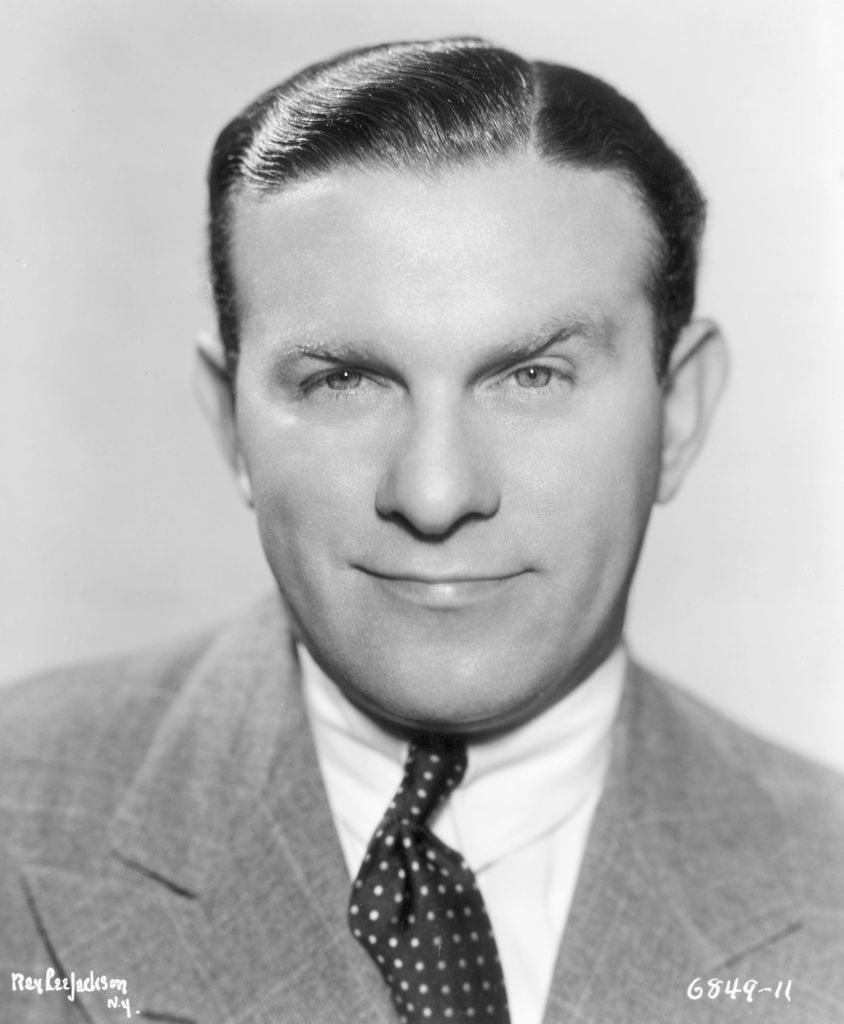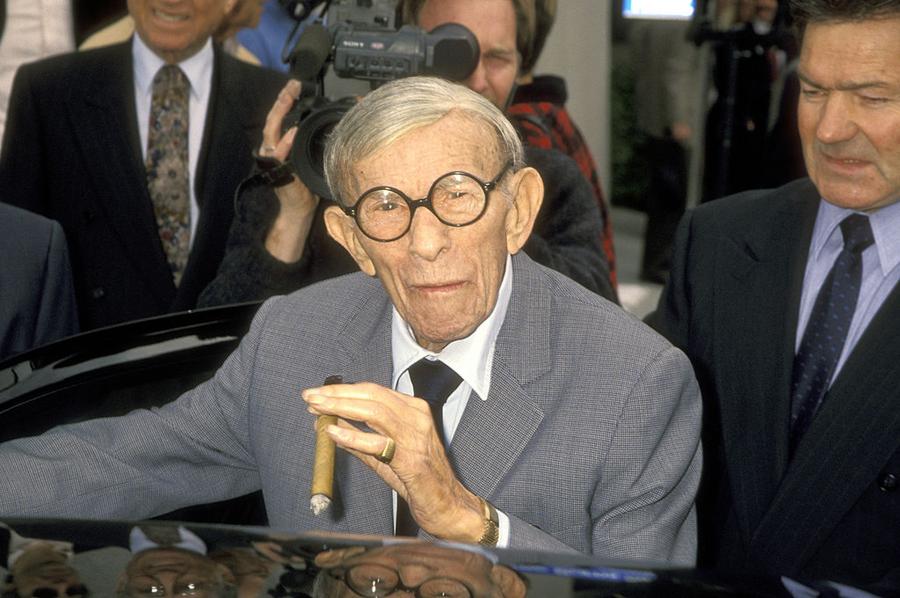George Burns at a Glance
- Categories: Celebrities, Celebrities > Comedians
- Net Worth: $20 Million
- Birthdate: Jan 20, 1896 - Mar 9, 1996 (100 years old)
- Birthplace: New York City
- Gender: Male
- Profession: Comedian, Actor, Television Producer, Radio personality, Writer
- Nationality: United States of America
- Height: 5 ft 6 in (1.7 m)
What Was George Burns’ Net Worth?
George Burns, a multi-talented American icon, left behind a legacy of laughter and entertainment. At the time of his passing in 1996, his net worth was estimated at a remarkable $20 million, a testament to his enduring career spanning radio, television, film, and vaudeville.
Burns achieved significant recognition throughout his career, including an Academy Award and a Golden Globe for his outstanding performance as Al Lewis in the 1975 film “The Sunshine Boys.” Beyond his solo achievements, Burns was famously known for his partnership with his wife, Gracie Allen, on “The George Burns and Gracie Allen Show,” which aired from 1950 to 1958. Following Gracie’s retirement due to health reasons, George continued to captivate audiences with “The George Burns Show” from 1958 to 1959.
Early Life
Born Nathan Birnbaum on January 20, 1896, in New York City, George Burns’ early life was marked by humble beginnings and a strong family connection. His parents, Hadassah and Eliezer, were Jewish immigrants who had come to the United States from what is now Poland. Growing up with 11 siblings, Burns’ father worked as a coat presser and served as a substitute cantor in a synagogue.
After the death of his father from the flu in 1903, George contributed to the family’s income through various jobs, including running errands, shining shoes, and selling newspapers. At the tender age of 7, he worked at a candy shop, making syrup. During breaks, he and his fellow child workers would harmonize in the basement, leading to the formation of the Pee-Wee Quartet. They performed in a variety of venues, from ferryboats and saloons to brothels and street corners, honing their talents and entertaining audiences.
Later, Burns worked as a curtain operator at a vaudeville theatre. This exposure to the world of entertainment further fueled his passion. In 1917, during World War I, he was drafted into the U.S. Army but was rejected due to his poor eyesight. He then adopted the stage name “George Burns” to distance himself from his Jewish heritage. He explained that he selected the name in homage to baseball players George J. Burns and George H. Burns. Early in his career, he often partnered with women for comic routines or dance performances, but it wasn’t until he met Gracie Allen in 1923 that his career truly took off. “And all of a sudden, the audience realized I had a talent. They were right. I did have a talent—and I was married to her for 38 years,” Burns once said.

(Photo by NBC Studios/Getty Images)
Career Highlights
George Burns’ career was incredibly diverse and spanned several decades. He and Gracie Allen began their careers with a series of short films in the late 1920s and early 1930s. They then transitioned to the silver screen, starring in films like “The Big Broadcast” (1932), “International House” (1933), and “Six of a Kind” (1934). In 1937, Burns co-starred with Fred Astaire in “A Damsel in Distress,” and in 1938, he joined Bob Hope in “College Swing.”
The duo also made a significant impact on radio. Their presence on the radio waves began in 1932 with “The Robert Burns Panatella Show,” followed by a string of successful programs including “The White Owl Program” (1933–1934), “The Adventures of Gracie” (1934–1935), “The Campbell’s Tomato Juice Program” (1935–1937), “The Grape Nuts Program” (1937–1938), “The Chesterfield Program” (1938–1939), “The Hinds Honey and Almond Cream Program” (1939–1940), “The Hormel Program” (1940–1941), “The Swan Soap Show” (1941–1945), “Maxwell House Coffee Time” (1945–1949), and “The Amm-i-Dent Toothpaste Show” (1949–1950).
In 1950, George and Gracie were given their own show on CBS, “The George Burns and Gracie Allen Show.” This show was a major success, airing 291 episodes over eight seasons and earning eight Primetime Emmy nominations. After Gracie’s retirement, Burns continued with “The George Burns Show” from 1958 to 1959. From 1964 to 1965, he starred in the ABC series “Wendy and Me,” which he also created, solidifying his status as a television pioneer.
Burns’ film career continued to flourish, with standout roles in “The Sunshine Boys” (1975), for which he earned critical acclaim and prestigious awards, including an Academy Award. He also notably played God in the “Oh, God!” series of films (1977, 1980, and 1984). Further demonstrating his versatility, he guest-starred on “The Muppet Show” in 1977 and co-starred with the Beatles in “Sgt. Pepper’s Lonely Hearts Club Band” (1978), where he played Mr. Kite. He also appeared in the films “Just You and Me, Kid” (1979) and “Going in Style” (1979), as well as the TV movie “Two of a Kind” (1982). In 1985, he hosted “George Burns Comedy Week” on CBS. In 1988, he starred in the film “18 Again!” which was inspired by his 1980 hit song, “I Wish I Was 18 Again.” In the 1990s, he made guest appearances on “The Golden Palace” (1993) and “Phenom” (1994), with his final film appearance being in “Radioland Murders” (1994).

(Photo by Ron Galella, Ltd./Ron Galella Collection via Getty Images)
Personal Life
George Burns had a rich personal life, marked by both love and loss. He was married to Hannah Siegel for a brief period, from September 5, 1917, to May 1918. Their marriage was short-lived, ending in divorce. His life’s most significant relationship began when he married Gracie Allen on January 7, 1926. They would remain together until her death in 1964. Together, they adopted two children, Ronald and Sandra. Ronald played their son on “The George Burns and Gracie Allen Show,” while Sandra also made occasional appearances.
Burns and Allen’s partnership was one of the most beloved in entertainment history. Their chemistry and comedic timing were unparalleled, and their marriage stood as a symbol of enduring love. After Gracie’s death from a heart attack, Burns was reportedly devastated. He struggled to cope with the loss, even sleeping on her side of the bed to feel closer to her, according to an associate, Tom Fontana.
Burns also experienced the loss of his close friend, Jack Benny, in 1974. Benny passed away from pancreatic cancer. At Benny’s funeral, Burns delivered a heartfelt eulogy: “Jack was someone special to all of you, but he was so special to me … I cannot imagine my life without Jack Benny, and I will miss him so very much.” These losses profoundly shaped his life and are a testament to the deep connections he formed throughout his life.

CARLOS SCHIEBECK/AFP/Getty Images
Final Years and Death
George Burns lived a long and fulfilling life, celebrating his 100th birthday before passing away. As he aged, he remained an active figure in the public eye. In honor of his 90th birthday, Hamel Road in Los Angeles was renamed “George Burns Road,” and on his 99th birthday, part of Alden Drive was renamed “Gracie Allen Drive.” Burns, with his characteristic wit, attended the unveiling ceremonies. He quipped, “It’s good to be here at the corner of Burns & Allen. At my age, it’s good to be anywhere!”
Even in his later years, he maintained his independence. He drove until he was 93, after which he hired chauffeurs. In July 1994, Burns underwent surgery to remove fluid from his skull after an accident. He reportedly contracted the flu at Frank Sinatra’s Christmas party in 1995. At the age of 96, he signed a contract with Caesars Palace, which included a performance on his 100th birthday, but he was unable to perform due to health reasons.
George Burns passed away peacefully at his Beverly Hills home on March 9, 1996, just 49 days after turning 100. His funeral was held three days later at Glendale’s Wee Kirk o’ the Heather church. He was interred with Gracie at Forest Lawn Memorial Park Cemetery. Their crypt is marked with the inscription “Gracie Allen (1902–1964) & George Burns (1896–1996)—Together Again,” symbolizing their enduring love and partnership.
Awards and Honors
Throughout his career, George Burns received numerous awards and honors recognizing his exceptional talent and contributions to entertainment. In 1976, he received an Academy Award for Best Actor in a Supporting Role and a Golden Globe for Best Actor in a Motion Picture – Comedy or Musical for his role in “The Sunshine Boys.”
His television work also earned him significant recognition. He received three Primetime Emmy nominations and won “Outstanding Performance in Informational Programming” for “A Conversation with…” in 1990. His other Emmy nominations were for “The George Burns One-Man Show” (1978) and “George Burns Celebrates 80 Years in Show Business” (1984).
Burns also showcased his musical talents, earning a Grammy for Best Spoken Word or Non-Musical Recording for “Gracie – A Love Story” in 1991. He received a nomination for Best Country Vocal Performance, Male for “I Wish I Was Eighteen Again” (1981), and a nomination for Best Comedy Album for “An Evening With George Burns” (1992).
His lasting impact was further acknowledged through Lifetime Achievement Awards from various organizations, including the American Comedy Awards, British Comedy Awards, Publicists Guild of America, and Screen Actors Guild Awards. He was inducted into the Online Film & Television Association Hall of Fame in 2005. In 1988, Burns received Kennedy Center Honors. He was also named Male Star of the Year at the 1975 Golden Apple Awards. He received two Saturn Award nominations from the Academy of Science Fiction, Fantasy & Horror Films, winning Best Actor for “Oh, God!” in 1978. At the 1980 Venice Film Festival, he received the Best Actor award for “Going in Style.” George Burns was honored with three stars on the Hollywood Walk of Fame, representing his achievements in television (1960), motion picture (1960), and live performance (1984). He and Gracie were inducted into the Television Hall of Fame in 1988.
Real Estate
During his life, George Burns was a successful real estate owner. He lived for 60 years in a Beverly Hills home. The house was built for $79,000 (including a pool and pool house). Shortly after his death, the home sold for over $2 million, reflecting the significant increase in property values in the area over the years and the association with a beloved celebrity.

